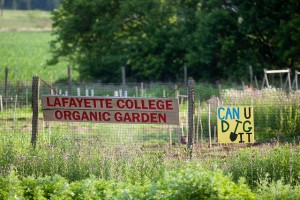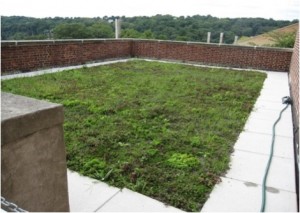In the course “Engineering and Public Policy: The Governance of Technology,” engineering studies and policy studies students see how their two fields go hand in hand.

The Lafayette Organic Garden at Metzgar Fields was the focus of a student project.
“Policy studies students focus on designing policies and navigating political systems to achieve social goals. Engineering studies students focus on designing technologies that can help achieve social goals,” says Benjamin Cohen, assistant professor of engineering studies, who teaches the course, which is required for both majors. “But they are both about building order into the world so we might live in better ways.”
The course explores three primary ways technology and politics are linked. How do we design policies about technologies? How do we use technologies in the policy-making process? How do technologies have political qualities?
According to Cohen, with everything from social media, nanotechnology, and unpiloted aerial vehicles (drones) to energy production, fuel-efficient cars, and genetically modified organisms dominating the news, it’s not difficult for the students to apply those questions to pressing topics. A recent class took a unique approach to the course’s questions by dividing into groups to tackle nine projects on the governance of environmental engineering in the Easton, Lehigh Valley, and broader mid-Atlantic region. Three focused on energy-related technologies, three on water distribution and management, and three on technologies related to local food production and distribution. Each group built a website to convey its findings and recommendations.
“I was interested in helping students see that technologies are not neutral, that they have political qualities, and that the way we design and police those technologies requires us to make political choices,” explains Cohen. “There’s a bigger issue at stake too. Those who build technologies—primarily engineers—play a significant role in how our world operates. But we also aspire to a strong democratic society, where citizens get to decide how society will work. So if an expert class like engineers takes charge of those decisions, then what does this say about democratic participation? It’s a challenge that requires citizens to think through the ways technology and participatory politics can go together. It was interesting to help the students see that they can do good engineering at the same time they’re promoting democratic systems.”

Here is the green roof on top of Acopian Engineering Center. A student team researched the possibility of installing more garden systems on campus and in Easton.
Although Cohen’s primary research focuses on the history of technology and the environment, the class treated the present as the historical context for their projects. Their starting point originated from a place of not knowing what happens next, of thinking about how to develop policies about technologies to build the future.
For Yue “Luna” Yuan ’12, who graduated with an A.B. with a major in policy studies and a B.S. in mechanical engineering, this course was right up her alley. She had visited the Lafayette Organic Garden before the class began and started becoming more interested in the U.S. food system, as well as the health, economic, and cultural issues related to food.
Yuan’s group treated food distribution and access as a matter of technology policy by exploring the concept of “food deserts,” areas in the industrialized world where the acquisition of healthy, affordable food is often difficult. The group found that these are almost exclusive to low-income neighborhoods, where factors like the reduced number of supermarkets and affordable fresh food stores, distances to a healthy food store, and socioeconomic status come into play. The group wanted to contribute to work that others in the region have been pursuing by determining whether these factors are causing a food desert in Easton.
By treating the food desert problem as one of design and infrastructure—citing stores, planning for storage and cooling, considering the transportation and energy demands on the local environment—the students were able to take their studies about technological systems and apply them to this local public policy issue.
Engineering studies major Carrie Cohen ’13 (Marblehead, Mass.) was part of a group studying electronic waste, known as “e-waste.” The group found that the biggest problem takes place long before electronics reach consumers, as corporations design products for quick turnover, creating enormous amounts of discarded electronics. They further explored the problem of e-waste within the three major contexts of the rise of electronics use, planned obsolescence, and wasting. They then researched the problem within the context of Lafayette to come up with some temporary solutions for the problem of e-waste on campus.
“Prior to taking this class, I wouldn’t have considered policy as something that might interest me. I love that I’m now interested in something I would have never known about,” Cohen says. “This project hit home how important it is to look at what created the problem rather than the problem itself. For example, the problem of e-waste is not really disposing of electronics—though that is a problem—but the real issue is planned obsolescence. We need to change the way electronics are marketed, and we need to change people’s habit of buying the latest and greatest model if we really want to solve the problem.”
This project offered an example of what Professor Cohen hopes can happen more often: one of the e-waste group members, Matthew Keehn ’12, who graduated with an A.B. in engineering, was able to carry forward the work as his senior capstone project this spring. He added to the e-waste website the group had created in the fall and then worked with Georges Xiques, campus sustainability manager, and Nestor Gil, assistant professor of art, to build an e-waste receptacle that is now housed in Farinon College Center for students to use for year-round disposal of their old electronics.
Other group projects in the course gave attention to organizational, cultural, and technical design elements as they studied technologies as socially and politically embedded systems, not just pieces of machinery. The projects included:
- sustainability at Lafayette
- the consequences of fracking (a water-intensive method of drilling used to extract underground resources such as natural gas) in the Lehigh Valley
- flood zones and the Williams Arts Campus
- green roofs
- grey water (reusable wastewater) and water management at Lafayette
- mapping the locality of the Easton Farmer’s Market
- mapping the Lafayette Organic Garden

